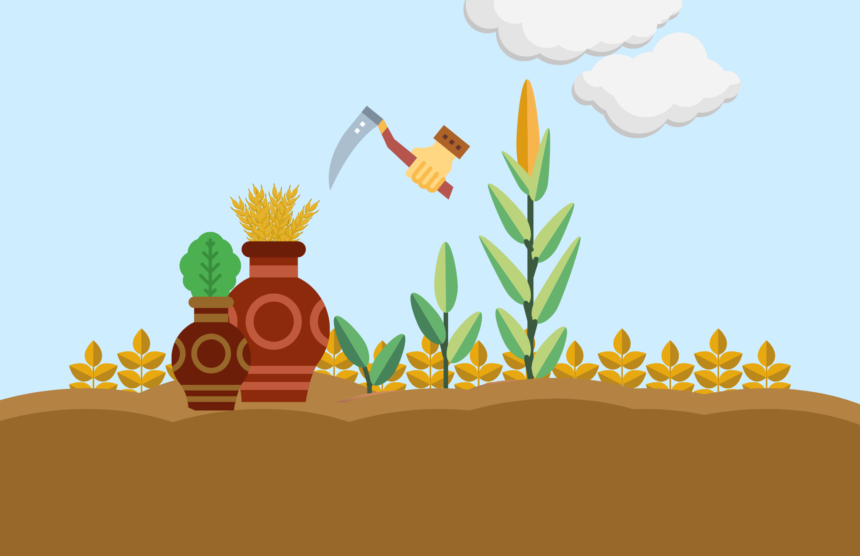
The Beginning of Farming
The Neolithic Age: The Beginning of Farming
The Neolithic age or known as “New Stone Age” gave rise to the beginning of farming, the basis of agriculture. This period of time has no exact start date because it began at different times in different regions. The earliest recorded agriculture production is in the Near East in 9,000 BCE and it spreads to East Asia 2,000 BCE. The development of agriculture dramatically changed the lives of early humans in the beginning once farming was in full effect.
Despite the coined term “Agriculture Revolution”, which suggests a sudden change, the advancement of farming and creating tools was more of a gradual change, as you can see with the range of years it took to expand across different regions of the world. Before the full-time change of farming, many groups spent half the year hunting and foraging and the other half, usually winter, farming. Though for an old lifestyle, a few isolated hunter and gatherer tribes are still around to this day.1
However, the actual reason for the switch from hunting and gathering to sedentary farming is unknown. Possible theories include noticing climate change, which resulted in more wild plants. This observation led us to creating new tools and storage that were used to effectively cut and store more plants and grains. Another possible theory is the shortage of wild animals, such as the gazelle, in the Fertile Crescent.3
The beginning of farming; advancements methods & tools
When farming started to become the norm, farming methods and tools began to advance, which resulted in higher crop yield, jobs, and population growth. One method is crop rotation, which was one of the major reasons a higher crop and livestock yield was produced. Crop rotation is the practice of alternating what crops are planted in a certain field to increase soil fertility and nutrients. This practice was generally used with 2-4 different crops throughout the year, sometimes one for each season. At times, farmers would even let the land lay farrow. This promoted soil nutrients re-balancing, disrupting crop and pest disease cycles, and providing a place for natural wildlife to enjoy until planting resumed.
Crops
The most prominent crops grown in Europe at this time were: wheat, oats, rye, barley, peas, beans, and later used turnips and clover. Adding turnips to the crop rotations helped control the weeds and was a food source of animals. The clover increased the nitrate levels in the soil and provided excellent pasture fields and fertile soils. This allowed farmers to not have to always let the soil lie fallow in between rotations which further increased production and advancement. Both crop rotations and farrow lands increased soil fertility, which in turn, produced higher yields.
Livestock
For livestock, selective breeding was introduced to produce desirable traits by agriculturalist Robert Bakewell and Thomas Coke during the mid-18th century. Eventually, it became easier to keep more farm animals around. This led to livestock increasing in size and produce more quality products such as milke, cheese, meat, and manure for fertilizer. Led by Robert Bakewell, this method is how the beef cattle industry started. Common farm animals were cattle, pigs, goats, sheep, and poultry.
Farming Tools
Farming tools that quickly advanced were the seed drill, thresher, and the plow. The benefits of these advancements increased efficiency, time management, productivity, new designs, and higher yield. Soon after the new tools and land enclosure laws in the European countries, farming grew into a business rather than a way of sustaining life and many farmers lost their jobs. Secondly, with the new land laws, farm laborers migrated to cities looking to make a livable wage.
Originally, there was common land, which is simply a plot of land owned by a group of people or by one person, and others were able to hold traditional rights over the land. These rights included room to graze livestock, collect firewood, etc. People who owned these rights of common land were called commoners. Traditional rights and essentially, the life of a commoner ended when enclosures began taking over the English farm land. After farms were made into enclosures, exclusive rights were given to the owners and the value of the land increased.2 Did enclosures create positive or negative effects on the societies of the 1500s?
How Farming Enclosures Affected Society in the beginning
The enclosed farms began to grow and the more productive the farms became, the fewer workers the farm needed. This resulted in residents migrating to cities in search of work, eventually leading to the Industrial revolution. To reconcile, the government created Poor Laws to help out the commoners and gave them land to compensate for the loss of the Common Rights. Unfortunately, most of the land given was known as waste lands and did not help the problem. Soon, the population and rent began to rise because land became much more valuable due mostly to the lack of farmable land. This led to protests and mass revolts against parliament.
With little job offers and hard times, many were forced to move into cities. Though enclosed lands increased profit for the farmer who owned the land, it negatively affected the rest of the population. Enclosures are known to be a major factor in the Agricultural Revolution, as it is the reason for population growth, new technology, capitalist farmers, and the relocation of families that began the Industrial Revolution. Over the years, agricultural production increased in other areas further increasing populations as well as the global market.2
The Pros and Cons
With the agricultural revolution, nomadic groups transformed into settled civilizations we know today. However the changes in lifestyle from nomads to farmers left important negative traits that overshadow the positives. With as farming communities growing expontentially, they relied on less variety of plant species to live. Food shortages, famine, and starvation resulted from bad weather and diseases, wiping out entire crops. It did however drastically change our diet for the better. Introducing cereal grains, dairy, and having food a bit more readily available, gave them advantages over hunting and gathering cultures.
Before trade, certain crops cultivated and grew in different regions and climates. These first crops batch of crops planted were called founder crops. The initial batch consisted of emmer wheat, einkorn wheat, barley lentils, peas, chickpeas, flax and bitter vetch. Other crops commonly grown in Asia were rice and millet. Some experts believe this transition was too fast and is the reason why we are now seeing people with gluten intolerance/allergies.
Furthermore, with food more readily available, it changed our lifestyle to for the better. With food production increasing so did our appetites and diets. This new source of food was capable of feeding more. Is it possible the ability to instinctively know what was needed to eat was lost with farming?
Was having more food a good thing?
Slowly but surely, with the extra food, the agricultural industry grew and so did our global population. With food readily available, it was easier to raise children compared to hunting and gathering groups. With a rising population, problems arose regarding food production keeping up witht he demand. One solution involved Genetically Modified Organisms to help increase growth known as GMOs.
A GMO is a living being that was made from a genetically modified cell. This process is basically the equivalent of speeding up the natural selection process of cross-breeding organisms in hopes to obtain a desirable trait from one being into another. This growth method begins in a lab where people specifically choose a gene to place inside another DNA chain of one cell. That cell is then grown naturally as if it was the original species. Thus, creating a new organism with an added benefit.4 With the new cultivation of GMOs, the world population was again able to be fed.
Though some may argue that GMOs helped bolster a large population, others believe the negatively traits of these “chemicals” do more harm than good. Are GMOs more of a pro or a con of cultivated farming?
The Final Verdict
As evidence shows, humans have evolved from nomadic life; foraging for food, to settling down to practice year-round farming with permanent shelters. Farming provided more food security, routine, and a new way of life. In turn, though it led to an advancement in skills, business, and society, it also produced overpopulation . An abundance of food deteriorated our health especially with new consumption of a limited variety of fast foods. How did depending on the smaller variety of cultivated plants affect our later farming practices and daily lifestyle?
Do the pros or the cons matter more regarding farming in the beginning?
Can we reverse the cons of farming?
The true question is…can we restore our health?
References
https://www.ancient.eu/Neolithic/ 1
https://courses.lumenlearning.com/boundless-worldhistory/chapter/the-agricultural-revolution/2
https://geography.name/agricultural-revolution/3
https://ag.purdue.edu/GMOs/Pages/WhatareGMOs.aspx4
